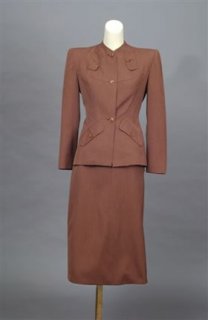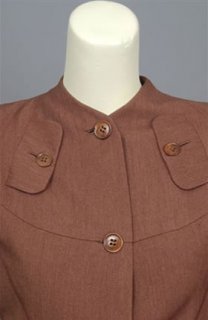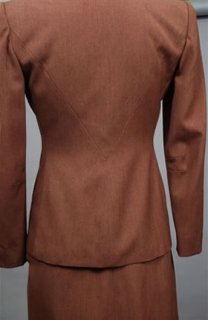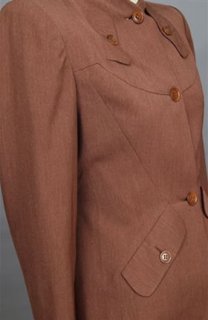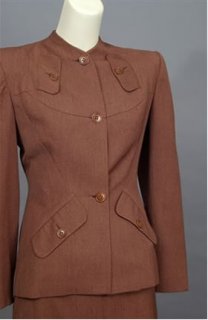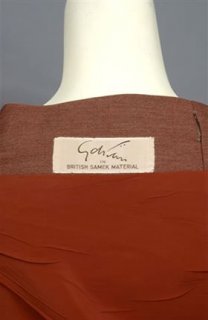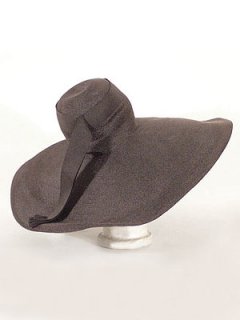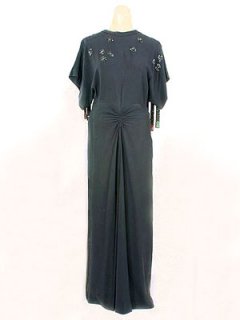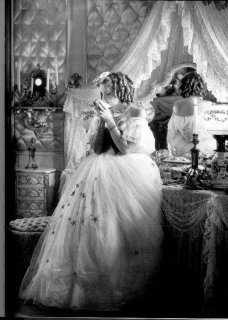You are using an out of date browser. It may not display this or other websites correctly.
You should upgrade or use an alternative browser.
You should upgrade or use an alternative browser.
1903–1959 Adrian
- Thread starter DosViolines
- Start date
DosViolines
far from home...
- Joined
- Aug 21, 2005
- Messages
- 3,212
- Reaction score
- 12
source: slate.com
culturebox
Designing Women
Remember when Hollywood stars wanted to look rich?
By Kate Taylor
Posted Wednesday, June 26, 2002, at 11:37 AM ET



In the 1980s, professional women who went to work in tailored suits with padded shoulders probably didn't know that their power look was actually a revival from a less socially enlightened time and place: Hollywood in the 1930s. The sharp Donna Karan and Armani suits in which these women conquered the business world recalled the suits and gowns in which Joan Crawford conquered the social world in movie after movie of the Depression and New Deal eras. Armani and Karan were taking their cue from a man who knew how to dress women on the make: costume designer Adrian.
Gilbert Adrian, who is currently the subject of an exhibit at the Met's Costume Institute, designed for MGM from 1928 to 1941 and dressed Crawford, Greta Garbo, Norma Shearer, Judy Garland, and Katharine Hepburn. His designs were widely copied. Half a million women bought a Macy's version of a ruffled dress Crawford wore in Letty Lynton (1932), partly because of its dramatic puffed-sleeve, cinched-waist look but mainly because of what Adrian's clothes meant when Crawford wore them: social opportunity, ambition, and a kind of magical transformative power that could take a poor girl and turn her into a member of the drawing-room set.
For poor women, Adrian's movies provided a view of the high life, and of high fashion, that they had never had before. In the 1937 movie The Bride Wore Red, Crawford played a prostitute trying to pass among nobles at a swank resort in the Alps. When her character said she picked up what she knew of upper-class etiquette from the movies, Crawford was describing a process of learning and assimilation that her own fans engaged in when they came to see her pictures.
The fantasy of vaulting into a higher social class really hit home during the 1930s. MGM cast Crawford in several of these Pygmalion roles, in which elegant clothes and manners transformed her from a working girl into a woman of fashion. It is Adrian's dramatic costumes that effect the transformation, both expressing her characters' aspiration and signaling their arrival. In Possessed (1931), in which Crawford plays a factory girl who goes to New York and attaches herself to a rich man, her broad-shouldered and assertive costumes express just what her character does when she announces to her skeptical boyfriend: "If I were a man, you'd think it was right for me to go out and get everything I could out of life. Why should men be so different? All they've got are the brains, and they're not afraid to use them. Well, neither am I!"
Even when Crawford stopped playing working girls and started playing socialites—roles that made it easier to use her as a fashion plate—Adrian's costumes still communicate hunger and restlessness, but also power. In the Letty Lynton dress, Adrian picked up on Elsa Schiaparelli's hesitant revival of the padded shoulder and produced a cloud of chiffon with huge ruffled sleeves that is both aggressive and childish at the same time. Later in the movie, when Crawford watches impassively as her playboy boyfriend drinks a poisoned glass of champagne she had prepared for herself, she wears a silver lamé cocktail suit, with a jaggedly cut, lethal-looking collar.
Crawford had her own rags-to-riches history—rising to stardom from the sales counter at a Kansas City department store—so Adrian was talking about both the actress and her on-screen persona when he said that movies and Hollywood style were for her "a belated finishing school." It's inconceivable to imagine any contemporary director or designer saying that of an actress or anyone else. Today, celebrities are hard-pressed to admit that their success and fame have changed them; they're always insisting that they haven't changed from their younger, pre-famous selves. We're contemptuous, and a little suspicious, of people who recreate themselves: Celebrity profiles praise those who stay in touch with their roots and "keep it real." In magazine and TV profiles, stars wear jeans or other casual clothing. One reason the awards-show circuit may be covered so relentlessly is that these events afford us our only opportunity to see stars look like stars, decked out in lavish evening gowns by top designers. But even at the Oscars, some of this year's styles—Gwyneth Paltrow's ruched, sheer Alexander McQueen top and Jennifer Connelly's sagging, flesh-colored Balenciaga—made their wearers look more like little match girls than the high-earning female powerhouses they are. Adrian is hardly the last Hollywood designer to explore clothing's power to disguise. What's changed is that today's clothes let celebrities go in drag as poor folks, instead of the other way around.
Kate Taylor is a writer living in New York.
DosViolines
far from home...
- Joined
- Aug 21, 2005
- Messages
- 3,212
- Reaction score
- 12
source: nytimes.com
May 17, 2002
DESIGN REVIEW; Adrian, Whose Elegant Styles Were Movie Scene-Stealers
By GRACE GLUECK
Although Gilbert Adrian (1903-1959) never appeared in a movie, he was one of the great Hollywood stars. As a designer of surpassing ability on the Metro Goldwyn Mayer talent team, he dressed Katharine Hepburn, Joan Crawford, Greta Garbo, Norma Shearer, Judy Garland and others for some of their most memorable film roles before setting out on his own to become a leading style maker in the American fashion industry.
Both of Adrian's roles -- as a fabricator of lavish Hollywood costumes and later as a creator of elegant, more restrained wearables for the rag trade -- are set out in ''Adrian: American Glamour'' at the Costume Institute of the Metropolitan Museum of Art.
The show was organized by a guest curator, Jane Trapnell Marino, who designs costumes herself for film and television, with the support of Harold Koda, curator in charge of the Costume Institute. It displays more than 80 of Adrian's high-style productions for the movies and the soignée suits and dresses with his signature inverted pyramid look that he created for the retail trade.
From the sleek, sexy flowing evening dress of white silk trimmed with gold braid that he designed for Ms. Hepburn in ''The Philadelphia Story'' (1940) to his lovably crackpot outfits for the Munchkins in ''The Wizard of Oz'' (1939), Adrian's movie concepts bore the mark of a designer who carefully thought everything through. And his output, in numbers alone, was amazing.
Ms. Hepburn's flamboyant but classy wardrobe perfectly fitted the aristocratic and extravagantly spoiled golden girl she played in ''The Philadelphia Story,'' as well as her long, lean frame. As for the Munchkins, the designer dressed them in flower-adorned felt costumes that not only reflected their garden setting but were each also ''a metaphor for the floral abundance of Munchkinland,'' writes Howard Gutner in ''Gowns by Adrian: The MGM Years, 1928-1941'' (Harry N. Abrams, 2001). Munchkin sketches were part of Adrian's 3,210 individual drawings for costumes in ''The Wizard of Oz.''
The long list of stars who have appeared on screen wearing this Connecticut-born designer's creations runs from Mary Pickford and Jean Harlow to Marie Dressler, Fanny Brice, Janet Gaynor (who married Adrian in 1939) and Ingrid Bergman. Topping the roster are the three actresses with whose movie images he is most associated: Garbo, Crawford and Shearer.
For Crawford, he came up with one of his most famous fantasies, the dreamy, filmy gown she wore in the ill-fated movie ''Letty Lynton'' (1932). Of white mousseline-de-soie, with huge puffed and ruffled sleeves, a ruffled peplum and three tiers of ruffles at the floor-length hem, it was a dress that female moviegoers apparently found irresistible. Said to have sold more than 500,000 knockoffs throughout the country, including a sweet little prom dress that is also in the show, it proved to the industry that it had a considerable role in setting trends for women's wearables.
Another Crawford floor-length getup for the same movie was a lot more sophisticated. Made of white silk crepe and black silk chiffon, with two sections of black bugle beading, it has a halter top and was skillfully draped to cling tightly to her body from hips to knees, ending in a bouncy flair. Although Crawford's broad shoulders were not emphasized in this particular costume, they may have helped inspire the square-shouldered look of Adrian's suits in his later designs for the fashion trade.
One of the show's more spectacular sights is the severe ensemble worn by Garbo in the throne room scene of ''Queen Christina'' (1933). A huge, heavy floor-length dress of brown cotton velveteen with long sleeves topped by layered epaulets, it is richly trimmed with silver embroidery in a geometric pattern. As a dress, it has the impact of an armored tank. It was reported that 15 women labored for six weeks on the elaborate ornamentation for the gown, said to be the costliest made at MGM up to that time.
But the quirky hats Adrian designed for Garbo in the film ''Ninotchka'' (1939) are a more memorable contribution to her onscreen persona. Along with several examples of his hats for later collections is a wonderful photograph of Garbo wearing the funky funnel-shaped topper that she had publicly scorned in her ''Ninotchka'' role as a Communist commissar visiting Paris, but secretly acquired when her comrades weren't looking. It was a hat definitely not meant to be a fashion statement, Adrian explained. However, it's a great Garbo statement.
In 1941, just before Pearl Harbor, Adrian left MGM to open his own fashion house. An influential couturier on his own, he paid little if any attention to what Paris did. Although he knew his Hollywood designs were too extreme for off-screen wear except for the boldest of fashion lovers, some of their esprit crept into his new line. A passionate painter all his life, he was also free at last to exercise his interest in 20th-century art movements and in the animal and patriotic motifs he had always cherished.
One of the better gowns bearing his animal motifs is his dashing ''Roan Stallion'' dress, a simple number with a high neckline, short sleeves and a stallion printed in red and white, charging boldly up the side and front. A little too cutesy for my taste, however, is a 1944 evening dress of black rayon crepe with two large printed white cats romping on it. Each of the cats wears a three-dimensional blue gingham bow.
Adrian's interest in art trends led him in the 1940's to design three Surrealist dresses of rayon crepe with prints by Salvador Dalí. But much more intriguing are the gowns from his ''Modern Museum'' collection, so called because they used concepts from Cubist masters. A case in point is his ''Shades of Picasso'' evening dress of 1945.
A knockout in beige rayon crepe, it has a complicated construction that includes a floating rectangle of fabric attached to the bodice by a bright pink sling. A bold zigzag of orange-rose fabric slithers down the back, beyond the hem. Not for the timid, the dress can't be accused of lacking pizazz.
Adrian also became noted for his women's suits, generally constructed with broad shoulders and nipped waists in jackets that ended well below the hip. They were remarkable for their ingenious, eccentric use of stripes, oddly placed pockets and complexities of tailoring. Unlike most designers, Adrian made a virtue of the War Production Board's restrictions on the use of cloth, eliminating cuffs and lapels, and reducing the size of collars and the number of pockets, a practice he continued after the war.
A perfect example of imagination coupled with elegant restraint is a playful suit of pink wool from 1946 that took off from the military jacket. With flyaway epaulets and round pockets, it made a nice transition from wartime winter to postwar spring.
All very handsome. Still, unless you're a zealous student of fashion, these later styles won't change your mind if you think Hollywood when you think Adrian.
DosViolines
far from home...
- Joined
- Aug 21, 2005
- Messages
- 3,212
- Reaction score
- 12
thehepburn
Member
- Joined
- Jul 15, 2005
- Messages
- 523
- Reaction score
- 0
Gilbert Adrian was one of the most quintessentially American of 20th-century designers as well as a Hollywood costumer of great renown, who dressed Greta Garbo, Norma Shearer, Katharine Hepburn, and Joan Crawford for the screen to memorable effect.
Katharine Hepburn wore Adrian creations in only 3 of her 40-something -- WOMAN OF THE YEAR, THE PHILADELPHIA STORY, and KEEPER OF THE FLAME. When I think of KH and costumes, I think of Walter Plunkett since she did so many RKO films. I have no idea why KH is mentioned in that sentence since the other 3 actresses mentioned were all longtime MGM contract players and KH was certainly not.
I prefer Travis Banton over Adrian anyway. Is there a Travis Banton thread?
DosViolines
far from home...
- Joined
- Aug 21, 2005
- Messages
- 3,212
- Reaction score
- 12
thehepburn said:I prefer Travis Banton over Adrian anyway. Is there a Travis Banton thread?
There's no thread on Travis Banton, maybe you could start one

DosViolines
far from home...
- Joined
- Aug 21, 2005
- Messages
- 3,212
- Reaction score
- 12
DosViolines
far from home...
- Joined
- Aug 21, 2005
- Messages
- 3,212
- Reaction score
- 12
source: katykane.com
1940's Gilbert Adrian Suit
Gilbert Adrian was already a very successful and influential Hollywood costume designer when he decided to open a retail clothing business in 1942.
His tailored suits with exaggerated shoulders soon became the look of the 1940's. He designed evening dresses with beadwork, and floral print country club dresses as well. These clothes allowed the American woman to have a little of the glamour of Hollywood during the wartime years.
This brown suit by Adrian is made form British Samek Material, a lightweight wool that he used in many of his tailored pieces.
The three button, collarless jacket has many of Adrian's signature details. There are darts that run from the shoulder seam to the yoke, and others that run from the yoke to the lower set of pockets. These are not just decorative, but are part of the construction and shaping of the garment. The yoke is decorated with two false pockets, and there are two functioning pockets on the hips. The back of the jacket has a central V shaped panel, adding great shape and fit. The narrow sleeves have two darts at the elbows. The jacket is lined in brown silk.
The pencil slim skirt is made from four panels, with a narrow waistband, and a metal zipper on the left side.
This suit was retailed by Bonwit Teller in New York City, and it is in excellent condition.
Attachments
- Joined
- Jan 21, 2004
- Messages
- 4,896
- Reaction score
- 3
wonderful... thx dos

MulletProof
Well-Known Member
- Joined
- Apr 18, 2004
- Messages
- 28,899
- Reaction score
- 7,979
the dresses on garbo are simply beautiful. 
nice thread dosviolines!.

nice thread dosviolines!.
DosViolines
far from home...
- Joined
- Aug 21, 2005
- Messages
- 3,212
- Reaction score
- 12
DosViolines
far from home...
- Joined
- Aug 21, 2005
- Messages
- 3,212
- Reaction score
- 12
Some more from "Letty Lynton"
Click images for larger version.





operagloves.com (2x); joancrawfordbest.com (3x)
Click images for larger version.





operagloves.com (2x); joancrawfordbest.com (3x)
DosViolines
far from home...
- Joined
- Aug 21, 2005
- Messages
- 3,212
- Reaction score
- 12
source: web2.unt.edu

Accession Number:
1986.011.015
Designer:
Gilbert Adrian
Object Date:
c. 1945
Label:
No Label
Description:
Ensemble consisting of black crepe skirt and jacket of black velvet embellished with gold braid and cabochon.
DosViolines
far from home...
- Joined
- Aug 21, 2005
- Messages
- 3,212
- Reaction score
- 12
From "Designing Women: Modernism in Hollywood Costume", from jetsetmodern.com
You can read the entire article here.
You can read the entire article here.
For all the fun Hollywood likes to poke at itself about overdressing actresses in movies like A Star Is Born, the key to designing for stars was found to be simplicity. Movie stardom of the classic era was a cult of personality, and the less interfering with the projection of a personality, the better. Individuality, at least at the star level, was carefully nurtured; the wardrobes of Joan Crawford, Norma Shearer, and Greta Garbo at M-G-M were at least as different as the ladies themselves, even though the same designer, Adrian (Gilbert Adrian Rosenberg) designed for all three.

In 1925, Gilbert Adrian designed for his second movie, The Eagle. He was already employing design tactics for which he would become famous, such as the use of asymmetrical appliques and a certain disdain for historical accuracy; the film was set in 1820 (1). Another costume for the movie shows an even heavier 1920's influence (2); the bandeau headdress with its Deco design of pearls was historically inaccurate, but few fans knew that. Some of Adrian's best work was done for Joan Crawford's films; his most famous dress for her was for 1932's Letty Lynton. The visual compression seen at the waistline and hipline are released in bursts of organdie ruffles at shoulder and hem (3). As the 1930's continued, Adrian continued to make use of high-contrast black and white (4). Adrian's most magnificent wardrobe is probably that for 1938's Marie Antoinette. Star Norma Shearer wears the designer's trademark detailing at her bustline, and his asymmetrical draping on her skirts (5). By the later 1930's, improvements in film technology made it possible for Adrian to use subtler effects, such as crystal-beaded fringe (6). The detail would been hard to photograph ten years previously.
Meeting the design goals of movie costuming- individuality, perfection of appearance, and fashionability- became a highly specialized field. Nothing was too much trouble. Stars were carefully assessed by costume departments, their photographic flaws found and corrected by whatever means were necessary. Every star had a "problem" area- or two, or three, or more- and Hollywood eventually found solutions for them all. Joan Crawford had short legs, and very wide, almost masculine shoulders. Adrian lengthened her legs by moving the waistline of her costumes slightly above her real one, and made brilliant use of her shoulders by exaggerating their width further with padding. This gave Crawford a more powerful look onscreen, giving her figure an attribute that had previously been considered "masculine"- the inverted triangle, wide at the shoulders, narrow at the hips.
Norma Shearer presented a different set of challenges for Adrian; her legs, by her own admission, were not her best feature. She also had a fairly stocky build, with a squarish torso. The legs were easy- Adrian covered them whenever possible, and Shearer was not often photographed full-figure if she was wearing short skirts. The waist was a bit trickier; corsetry helped for certain costumes. But the stressed shoulder line popularized by Crawford, and peplums (a pleated, skirt-like detail at the hip) were the usual solution, exaggerating both Shearer's shoulders and hips, narrowing the waist by comparison. Garbo was not difficult for Adrian to dress; she had no real figure problems aside from her height, greater than that of many male co-stars, and the only thing to do about that was to stand the fellows on boxes.
Adrian was able to dress anything from period epics to Art Deco romances to platoons of Munchkins for The Wizard of Oz. He evolved a very specific design vocabulary that is consistent across his oeuvre. First, he understood better than almost anyone else that the close-up is the most important shot in movie-making, which means that costumes are rarely seen full-length for more than a few seconds on-screen. Adrian's designs always have their greatest visual interest above the waist for this reason. He seldom did striking or intricate neckline details, feeling that they distracted from the face; he generally kept the emphasis on lapels, for which he had a seemingly endless store of inventiveness, or on shaped or applied details across the bust.
He also was one of the first to apply strong diagonals and asymmetry to screen costume- attributes rare in fashion prior to his time. Adrian often gave his ladies rakishly tilted hats that made a pleasing contrast to a symmetrically-balanced suit or dress, even in period costumes where it was not historically correct to do so. His greatest contribution, though, was in his adroit use of whites and blacks in costuming; when he began designing, film stocks and lighting had a hard time rendering subtly different shades. This made strong contrast essential, and Adrian became famous for his endless variations on the theme. A white flannel sports suit might have a black blouse with white polka dots, or a black wool dress for a secretary role might have an off-center white neckline and cuffs, as Joan Crawford's did in Grand Hotel. And Adrian was one of the leading exponents of the quintessential Thirties bias cut, a tricky technique that cut all panels of a dress at a 45-degree angle to the warp and weft of its fabric, instead of cutting straight along the grain. The result was a costume that draped and clung to every curve of stars like Jean Harlow, whose appeal and career owed much to the designer.
Bluestar07
Active Member
- Joined
- Nov 15, 2004
- Messages
- 4,556
- Reaction score
- 2
 Subscribing to this thread!!
Subscribing to this thread!! 
DosViolines
far from home...
- Joined
- Aug 21, 2005
- Messages
- 3,212
- Reaction score
- 12
[FONT=Verdana, Arial, Helvetica, sans-serif]Adrian Monkey Print Silk Dress
American, 1940s, Of ivory lightweight silk printed with vertical pattern of monkeys swinging from leafy branches.
Sold for $12,925
doylenewyork.com
[/FONT]
American, 1940s, Of ivory lightweight silk printed with vertical pattern of monkeys swinging from leafy branches.
Sold for $12,925
doylenewyork.com
[/FONT]
Attachments
DosViolines
far from home...
- Joined
- Aug 21, 2005
- Messages
- 3,212
- Reaction score
- 12
Adrian custom designed straw hat with gros-grain ribbon trim, c.1940. Label: "Adrian Custom."
vintagetextile.com
vintagetextile.com
Attachments
DosViolines
far from home...
- Joined
- Aug 21, 2005
- Messages
- 3,212
- Reaction score
- 12
Adrian beaded/sequined crepe evening gown with back streamers, c.1942. Labels: "Adrian Original" and "The French Shops/Filene's/Boston."
vintagetextile.com
vintagetextile.com
Attachments
What dream dresses he made  Probably my favourite costume movie ever - Camille 1936. (gonemovies.com)
Probably my favourite costume movie ever - Camille 1936. (gonemovies.com)
The only quote by him from imdb:
"When the glamour goes for Garbo, it goes for me as well." - the reason Adrian gave for leaving MGM.
 Probably my favourite costume movie ever - Camille 1936. (gonemovies.com)
Probably my favourite costume movie ever - Camille 1936. (gonemovies.com)The only quote by him from imdb:
"When the glamour goes for Garbo, it goes for me as well." - the reason Adrian gave for leaving MGM.
Attachments
Last edited by a moderator:
Similar Threads
- Replies
- 12
- Views
- 8K
- Replies
- 14
- Views
- 17K
- Replies
- 48
- Views
- 6K
- Replies
- 116
- Views
- 93K
- Replies
- 125
- Views
- 126K
Users who are viewing this thread
Total: 1 (members: 0, guests: 1)
New Posts
-
-
Vogue Italia February 1995 : Michelle Behennah by Steven Meisel (1 Viewer)
- Latest: thearchivecollector
-
-
-











